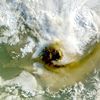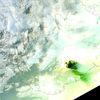Veggspjaldiš, smelliš į til aš sjį.
Veggspjald sem kynnt var į rįšstefnu EGU ķ Vķn og Vorrįšstefnu Jaršfręšafélagsins ķ aprķl 2011.
Įgripiš (į ensku)*:
High levels of particulate matter due to ash plume and ash re-suspension following the Eyjafjallajökull eruption.
Throstur Thorsteinsson1, Thorsteinn Johannsson2 and Gudrun Petursdottir3
1Institute of Earth Sciences, University of Iceland, Sturlugata 7, 101 Reykjavik (ThrosturTh@gmail.com), 2The Environment Agency of Iceland, Sudurlandsbraut 24, 108 Reykjavik, 3Institute for Sustainability Studies, University of Iceland, Gimli v/ Hįskólatorg, 107 Reykjavķk
The dangers to people living near a volcano due to lava and pyroclastic flow, and, on ice or snow covered volcanoes, jökulhlaup (floods) are well known. The level of risk due to ash fall is, however, not as well known.
The eruption at Eyjafjallajökull, 14 April to 20 May 2010 (last day of visible plume), produced abundant particulate matter (PM). After the volcanic activity ceased high PM concentration has been measured on several occasions, due to re-suspended ash.
The particulate matter (PM10) concentration in the small town of Vķk, 38 km south-east from the erupting Eyjafjallajökull volcano, reached levels that are 25 times the recommended health limit of 50 mg m-3 averaged over 24 hours, on 7 May 2010, with 10-min values reaching 13000 mg m-3. Even after the eruption, values as high as >8000 mg m-3 (10-min average), and >900 mg m-3 (24-h average), were measured.
In Reykjavik, 125 km WNW of the volcano, the PM10 concentration reached over 2000 mg m-3 (10-min average) during an ash storm event on 4 June 2010. The annual concentration in Reykjavik is about 25 mg m-3, and the only previous events of comparable magnitude are peaks during New Year's Eve celebration.
The eruption at Eyjafjallajökull posed a potential health risk to the inhabitants in the regions hit by severe ash fall. However, preliminary studies indicate that the ash has had minor short term health effects. Studies show that the crystalline silica content of the ash is negligible, so that the persistence of deposited ash in the soils and environment should not present a significant silicosis hazard. During periods of PM10 concentration over about 5000 mg m-3, most residents stayed indoors, or wore protective air filters and goggles when they had to go outside.
A study is ongoing to examine the potential long term health effects of the volcanic eruption, including the high concentration of PM10 during and after the eruption due to re-suspended ash in the area.
* Vinsamlegast hafiš samband viš Žröst (finniš tölvupóstfang į veggspjaldi) ef viljiš vitna ķ eša nota gögn sem birtast į veggspjaldinu.
Flokkur: Vķsindi og fręši | Sunnudagur, 17. aprķl 2011 (breytt kl. 14:41) | Facebook
Fęrsluflokkar
Tenglar
Mķnir tenglar
- ThrosturTh.wordpress.com Blogg į ķslensku sem tekur viš af žessu - mešan ekki gengur aš nota žetta.
| Jślķ 2025 | ||||||
| S | M | Ž | M | F | F | L |
|---|---|---|---|---|---|---|
| 1 | 2 | 3 | 4 | 5 | ||
| 6 | 7 | 8 | 9 | 10 | 11 | 12 |
| 13 | 14 | 15 | 16 | 17 | 18 | 19 |
| 20 | 21 | 22 | 23 | 24 | 25 | 26 |
| 27 | 28 | 29 | 30 | 31 | ||
Heimsóknir
Flettingar
- Ķ dag (2.7.): 0
- Sl. sólarhring:
- Sl. viku: 2
- Frį upphafi: 0
Annaš
- Innlit ķ dag: 0
- Innlit sl. viku: 2
- Gestir ķ dag: 0
- IP-tölur ķ dag: 0
Uppfęrt į 3 mķn. fresti.
Skżringar


 apalsson
apalsson
 gattin
gattin
 vulkan
vulkan
 hoskibui
hoskibui
 svatli
svatli





Bęta viš athugasemd [Innskrįning]
Ekki er lengur hęgt aš skrifa athugasemdir viš fęrsluna, žar sem tķmamörk į athugasemdir eru lišin.